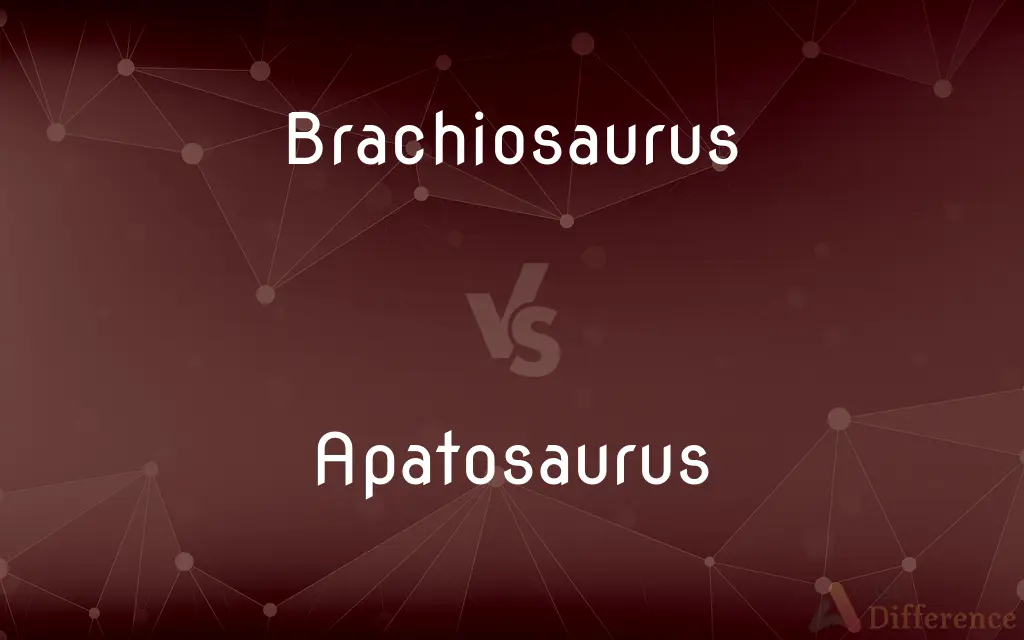Brachiosaurus vs. Apatosaurus — What's the Difference?
By Tayyaba Rehman — Updated on October 26, 2023
Brachiosaurus was a tall herbivorous dinosaur with longer front legs, while Apatosaurus, also herbivorous, had a longer body and tail with comparatively similar leg lengths.

Difference Between Brachiosaurus and Apatosaurus
Table of Contents
ADVERTISEMENT
Key Differences
Brachiosaurus and Apatosaurus are both iconic dinosaurs that roamed during the Late Jurassic period. Brachiosaurus is particularly recognized for its unique physique: its front legs were notably longer than its hind legs, giving it a more upright posture. In contrast, Apatosaurus had legs of a more similar length, giving it a more horizontal stance.
The size and stature of Brachiosaurus allowed it to reach and graze on the higher branches of trees. This is distinct from many other sauropods, including the Apatosaurus, which likely fed on lower vegetation due to its horizontal orientation. The Apatosaurus, however, boasted an incredibly long neck and tail, which could have been used for a range of functions including balance and communication.
When it comes to physical appearance, Brachiosaurus had a small skull compared to the rest of its body and a rather large nostril on its forehead. Apatosaurus, on the other hand, had a larger head and its nostrils were situated more conventionally at the end of its snout. The body of Apatosaurus was robust and muscular, especially when compared to the somewhat sleeker physique of the Brachiosaurus.
In popular culture, both Brachiosaurus and Apatosaurus have often been misidentified or confused for one another. The Apatosaurus was even once mistakenly called "Brontosaurus". Regardless, both these giants are testaments to the incredible biodiversity and evolutionary wonders of the dinosaur era.
Comparison Chart
Posture
More upright due to longer front legs
More horizontal due to similar leg lengths
ADVERTISEMENT
Dietary Adaptation
Likely grazed on higher branches
Likely fed on lower vegetation
Physical Features
Smaller skull, large nostril on forehead
Larger head, nostrils at end of snout
Body Shape
Somewhat sleeker
Robust and muscular
Misidentifications
Occasionally confused with other sauropods
Mistakenly called "Brontosaurus" in the past
Compare with Definitions
Brachiosaurus
A tall Jurassic dinosaur with front legs longer than its hind.
The Brachiosaurus could reach the treetops due to its height.
Apatosaurus
A herbivore from the Jurassic period with a horizontal stance.
The Apatosaurus moved gracefully across the plains, grazing on low vegetation.
Brachiosaurus
A herbivorous sauropod with a unique upright posture.
The Brachiosaurus stood out among its peers because of its distinctive stance.
Apatosaurus
A large sauropod dinosaur with a long neck and tail.
The Apatosaurus's lengthy tail left an impression on those who studied its fossils.
Brachiosaurus
A sauropod that could potentially graze on tall vegetation.
With its height advantage, the Brachiosaurus had access to food sources others couldn't reach.
Apatosaurus
A sauropod with a robust and muscular physique.
The Apatosaurus, with its strong body, could potentially defend itself from certain predators.
Brachiosaurus
One of the more massive dinosaurs with long neck and tail.
The Brachiosaurus, with its massive size, roamed the lands over 150 million years ago.
Apatosaurus
A dinosaur once mistakenly termed "Brontosaurus".
The Apatosaurus was at the center of a naming controversy in paleontology.
Brachiosaurus
A dinosaur known for its small skull and nostril placement on its forehead.
The unique head features of the Brachiosaurus are unmistakable in skeletal reconstructions.
Apatosaurus
A herbivorous giant that roamed North America.
Fossil evidence shows that the Apatosaurus lived in what is now the western United States.
Brachiosaurus
Brachiosaurus () is a genus of sauropod dinosaur that lived in North America during the Late Jurassic, about 154–153 million years ago. It was first described by American paleontologist Elmer S. Riggs in 1903 from fossils found in the Colorado River valley in western Colorado, United States.
Apatosaurus
Apatosaurus (; meaning "deceptive lizard") is a genus of herbivorous sauropod dinosaur that lived in North America during the Late Jurassic period. Othniel Charles Marsh described and named the first-known species, A. ajax, in 1877, and a second species, A. louisae, was discovered and named by William H. Holland in 1916.
Brachiosaurus
A large brachiosaurid dinosaur of the genus Brachiosaurus of the Jurassic Period, with the nostrils and eyes set high up on the head. Also called brachiosaur.
Apatosaurus
A very large herbivorous sauropod dinosaur of the genus Apatosaurus of the Jurassic Period, having a long neck and tail and a small head.
Brachiosaurus
A large herbivorous sauropod dinosaur, Brachiosaurus altithorax, which lived during the Jurassic period.
Apatosaurus
A large sauropod dinosaur of the genus Apatosaurus of the late Jurassic Period. Apatosaurs had a long neck and tail and a relatively small head.
Apatosaurus
A genus of extinct dinosaurs comprising the brontosaurs; apatosaurs.
Apatosaurus
Huge quadrupedal herbivorous dinosaur common in North America in the late Jurassic
Common Curiosities
Was Apatosaurus ever called by another name?
Yes, Apatosaurus was mistakenly called "Brontosaurus" in the past.
What was the primary diet of Apatosaurus?
Apatosaurus was a herbivore and likely fed on low vegetation due to its horizontal stance.
When did the Brachiosaurus live?
The Brachiosaurus lived during the Late Jurassic period, around 150 million years ago.
What distinguishes the posture of Brachiosaurus from other sauropods?
Brachiosaurus had longer front legs than hind legs, giving it a unique, more upright posture.
How tall was a Brachiosaurus?
Brachiosaurus could reach heights of up to 85 feet or more.
Where have Apatosaurus fossils been found?
Apatosaurus fossils have been predominantly found in the western United States.
Which dinosaur had a more upright posture, Brachiosaurus or Apatosaurus?
Brachiosaurus had a more upright posture due to its longer front legs.
Were Brachiosaurus and Apatosaurus the same size?
No, while both were large, their sizes varied, with Brachiosaurus generally being taller due to its longer front legs.
How long was the tail of an Apatosaurus?
Apatosaurus had an extremely long tail, spanning many feet and potentially making up half its length.
Did Brachiosaurus and Apatosaurus live during the same time period?
Yes, both Brachiosaurus and Apatosaurus lived during the Late Jurassic period.
Which of the two had a longer neck, Brachiosaurus or Apatosaurus?
While both had long necks, Brachiosaurus is often thought to have had a slightly longer neck.
Are there any modern relatives of Brachiosaurus and Apatosaurus?
Birds are considered the closest living relatives of all dinosaurs, including Brachiosaurus and Apatosaurus.
Were Brachiosaurus and Apatosaurus carnivorous?
No, both Brachiosaurus and Apatosaurus were herbivorous.
Where does the name "Brachiosaurus" come from?
The name "Brachiosaurus" is derived from the Greek words for "arm" and "lizard," referencing its long front limbs.
Why was Apatosaurus once called "Brontosaurus"?
A misidentification in the late 19th century led to the use of the name "Brontosaurus" before it was corrected to Apatosaurus.
Share Your Discovery

Previous Comparison
Retiring vs. Shy
Next Comparison
Oxyhemoglobin vs. DeoxyhemoglobinAuthor Spotlight
Written by
Tayyaba RehmanTayyaba Rehman is a distinguished writer, currently serving as a primary contributor to askdifference.com. As a researcher in semantics and etymology, Tayyaba's passion for the complexity of languages and their distinctions has found a perfect home on the platform. Tayyaba delves into the intricacies of language, distinguishing between commonly confused words and phrases, thereby providing clarity for readers worldwide.














































